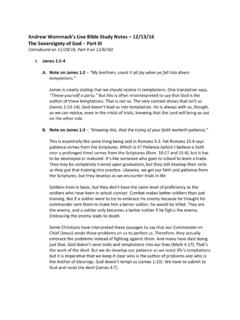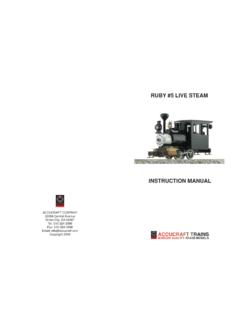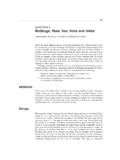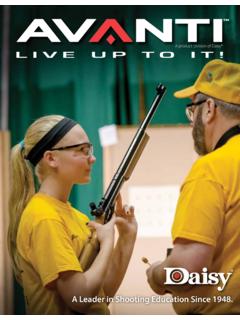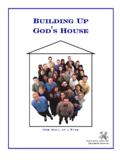Transcription of Building Instructions for a Propane Gas Forge …
1 Building Instructions for a Propane GasForge(Burner System)Technical DrawingI. General DescriptionII. Mode of FunctioningIII. Building AdviseIV. OperationV. Safetycomposed by Helmut Hillenkampiron-to (Remark: This Forge system has been used as described inEcuador. To use in your country, you must check and comply withapplicable local and national safety codes.)Parts List1. One 1/2" pipe cap (all pipe and fittings are to be unplated).2. 17" of 1/2" pipe, threaded on both Coupling, 1/2" pipe thread to hose fitting One 2" to 3/4" bell One brass orifice fitting drilled with a: #66 drill for sea leveloperation.
2 #67 drill for 3,500 ft. elevation operation. #68 drill for7,000 ft. One piece of 3/4" pipe 4" long, threaded on one One piece of mild steel 1/8" x 8" x 8".8. One piece of 1" pipe 2 1/2" 20 feet of 350 PSI 1/4" Propane hose with appropriate One 0-100 PSI gas pressure regulator or POL fitting withexcess flow Nut, 3/8" NC (unplated).13. Scrap to provide handle for turning the 3/8" One 3/8" bolt, 2 1/2" General DescriptionWe are presenting a furnace system whose only fuel isPropane/Butane. It was developed in adaptation of a type of forgefurnace as it has been used in the USA in recent years mainly byhorseshoers.
3 It can be taken in the back of a pick-up truck right tothe stable of the customers to shoe their horses. No electricity isneeded for its use. Because of its high performance and cleancombustion, artists blacksmiths too are using it more and moreinstead of the coal would probably be ideal to have both systems available and tohave the choice to use one or the other according to the jobrequirements. With the gas Forge it is easier to obtain long uniformheats than with the coal Forge , 8 in. with one burner and 4 in. morewith each additional burner. The temperature can be adjusted so asto be able to keep allways several irons in the fire without burningthem.
4 With sufficiently high gas pressure and adequate layout ofthe combustion chamber (insulating firebricks or ceramic fiber), itis easily possible to achieve the high temperatures needed forforge welding. Using only cheap red construction bricks wereached a temperature of 2880 F in the test Forge in Cuenca. Weare not talking about a scientific high performance device here, butabout a practical tool for daily use in the hot iron shop. All partsfrom which it is composed are available in the country (Ecuador),mostly from national production. For a handy craftsman it shouldbe relatively easy to copy, once the mode of functioning Mode of FunctioningThe gas ( Propane , Butane, or a mixture of both - here calledcooking gas) streams under pressure out of the orifice to the principle of Venturi a depression takes placeinside the bell reducer 4 which leads to the suction or air into gas/air mixture then streams through a 3/4" burner pipe 6 thatexpands to 1", 8, into the combustion chamber.
5 There it burns witha hot flame. To do this it needs a baffle plate at a distance of 5 more, so a back pressure gets created and the flame does notblow itself out. The floor of the furnace normally serves as thisbaffle plate. During operation it gets particularly hot, and the heatradiated from the walls and floor helps to warm up the iron morerapidly. Similarly to the coal Forge the rule is: "No cold iron into acold Forge ."First let the Forge heat up well, then place the iron in it. For thecombustion only the air entering through the burner pipe 6/8 only possibility to change the fuel/air ratio during operationconsists in reducing the air flow.
6 This can be done using the choke12/14. The choke eases the lighting and warming up of the Forge ,similar to a car engine. It is also used to reduce the forming ofscale on the iron. In a reducing atmosphere the iron doespractically not oxidize and can be kept hot for long periods of timewithout volume losses through scaling. A reducing flame producesless heat though, and there is also the danger of poisonous carbonmonoxide mixing with the shop air (see chapter V. Safety).During normal use some scale will form and jump off whenhammering on the anvil. This can lead to burns. ALLWAYSWEAR SAFETY GOGGLES WHEN WORKING.
7 Leather glovesare Building AdviseThe connection to the gas tank consists of a direct outlet withoutpressure regulator 11. With it the flow can be adjusted to a certaindegree. A rubber hose 10 is attached to it by hose clamps 9 andleads the gas to the burner. This hose should be as strong aspossible. In no case should it consist of plastic or PVC, becausethis would soften and weaken with heat. The best is a quality of350 psi pressure resistance (printed on the side of the hose). Istrongly recommend using a pressure regulator (0-100psi) or anexcess flow shutoff valve as supplied with weed burners on thecylinder.
8 Also use at least 10ft of hose to keep tank and Forge at aminimum distance from each other. From the hose 10 the gasstreams into the gas entry pipe 2 which is plugged on the far end1. On its belly it has a hole into which the suitable thread for theorifice 5 is tapped. Before tapping the thread this spot may beflattened with the hammer a little bit. This improves gas tightness,since the orifice will not seat in a rounded section but in a flat oneinstead. If this spot is not tight, additional gas will stream out herein an uncontrolled manner and lead to an overly rich mixture andto over the orifice 5 a bell reducer 4 of 2" x 3/4" is 3/4" pipe 6 is threaded on one end and its other end is welded toa piece of 1" pipe 8.
9 The inside gets smoothed from cutting burrswith a round file. A hole is drilled from the side and a nut 12 of3/8" welded to it. This nut gets retapped after welding so that theadjustment bolt 14 of the choke can be easily screwed into it. Allpipes and fittings should be black (not galvanized).Depending on the thickness of the used bricks, a square plate 7with hole gets welded to the burner pipe 8 so that this pipe doesnot protrude into the combustion chamber. The actual nozzle ofthe burner is formed by the canal rasped into the brick. Thusoverheating and burning of the pipe is avoided. The plate supportsthe burner mechanically and makes the canal airtight againstsecondary air.
10 Therefore the weld needs to go completely aroundthe combustion chamber itself is formed in the most simple casefrom piled-up bricks. The red construction bricks bought and madein Cuenca stood up to daily use for about four weeks before someof them had to be replaced. Firebricks are here about 20 times asexpensive as construction bricks, and their use in the small shop israrely justified. Lightweight firebricks and ceramic fiber havebetter insulating properties and allow a more rapid heating up ofthe Forge and attainment of higher temperatures. If forgewelding isdesired, the floor material of the Forge should not be fromlightweight firebricks, because they dissolve with Borax and heat(eutectic reaction).

